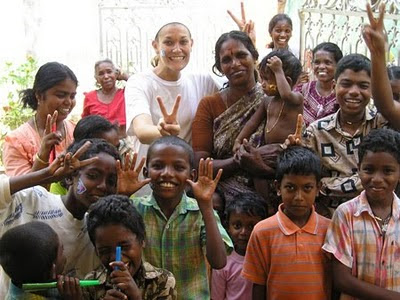
Dravidian People
The HUGO Pan-Asian SNP Consortium (HPASC) (Mapping Human Genetic Diversity in Asia) has done much to bring the genetic data for India in line with the archaeological, anthropological and linguistic data. Ray and Excoffer argue that coupling the archaeological data with genetic data is a powerful way to infer population migration (1).
Before this research by HPASC, researchers have noted the absence of congruency between Indian population genetics and archaeological research (2) As a result research into India population studies are not supported by historical, archaeological and linguistic evidences (3). The archeological evidence indicated that the first settlers of India were probably Negritos and Austro-Asiatic, then Dravidian speakers and finally Southeast Asians (4-5). But Geneticists maintain that the Dravidian speakers originated in India (6-7). They support this view by showing how the Indian mtDNA belonging to the M haplomacrogroup must have developed in situ in India (7).
Some researchers use Rosenberg et al. to argue that there is a low
level of genetic divergence across geographically and linguistically diverse Indian populations based on their analysis solely of Indo-Aryan and Dravidian speakers from India (8-9).
This study by HPASC contradicts Rosenberg et al and supports the view that the Indian populations are not homogenous and that Negritos were probably the first settlers of India. Using an Indian sample from India, HPASC acknowledges that the Dravidians were probably not the first population to settle India. The research of HPASC also supports an Indo-European migration into India.
The HPASC finding is supported by linguistic and archaeological evidence that indicated a Dravidian substratum in the Indo European languages and the major probability those Rosenberg et al. use of only Indo- Aryan and Dravidian speakers in the United States as a representative sample of diverse Indian populations was not an accurate example of the linguistic and geographical diversity of Indian populations because TMRCA of the Indo-Aryan and Dravidian speakers in India was probably a Proto-Dravidian speaker and a high level of genetic divergence across Indian populations (11) . A shared MRCA for Dravidian and Indo-Aryan speakers , is supported by the Dravidian substratum in Indo-European languages which indicates that the speakers of these languages lived in intimate contact in North India for 1000s of years .
The finding of heterogeneity in ancient India by the HUGO Pan –Asian SNP Consortium is inconformity with the archaeological and linguistic data. This makes the research of HPASC significant and suggests future studies which will provide keen insight into the ancient human demography in India and the rest of Asia.
Reference:
1. Ray N, Excoffier L.2009. Inferring past demography using spatially explicit population genetic models. Human Biology, 81 (2-3): 141-157.
2. Tripathy V, Nirmala A, Reddy BM. 2008. Trends in Molecular Anthropological Studies in India. Int J Hum Genet, 8(1-2): 1-20.
3. Winters,C. 2008.Origin and Spread of Dravidian Speakers Int J Hum Genet, 8(4): 325-329 (2008)
4. Cordaux R, Saha N, Bentley GR, Aunger R, Sirajuddin SM, et al. (2003) Mitochondrial DNA analysis reveals diverse histories of tribal populations from India. Eur J Hum Genet 11: 253–264.
5. Kumar V, Reddy ANS, Babu JP, et al. (2007). Y-chromosome evidence suggests a common paternal heritage of Austro-Asiatic populations. BMC Evolutionary Biology, 7:47.
6. Rajkumar R, Banerjee J, Gunturi HB, Trivedi R, Kashyap VK. 2005. Phylogeny and antiquity of M macrohaplogroup
inferred from complete mtDNA sequence of Indian specific lineages. BMC Evo. Bio., 5: 26.
7. Thangaraj K, Chaubey G, Singh VK, Vanniarajan A, Thanseem I, Reddy AG, Singh L. 2006. In situ origin of deep rooting lineages of mitochondrial macrogroup M in India. BMC Genome, 7: 151.
8. Rosenberg NA, Mahajan S, Gonzalez-Quevedo C, Blum MGB, Nino-Rosales L, et al.. 2006. Low Levels of Genetic Divergence across Geographically and Linguistically Diverse Populations from India. PLoS Genet, 2(12): e215 DOI: 10.1371 /journal.pgen.0020215
9. Winters C (1989). Review on Dr. Asko Parpola’s ‘The Coming of the Aryans’. International Journal of Dravidian Linguistics 18 (2): 98-127.
10. Krishnamurti K 2001. Comparative Dravidian linguistics: Current perspectives. Oxford: Oxford University Press.
11. Winters CA 2007. High Levels of Genetic Divergence across Indian Populations. PloS Genetics. Retrieved 4/8/2008 http://www.plosgenetics





